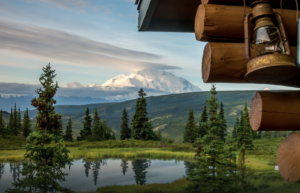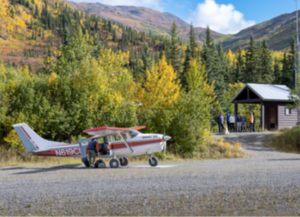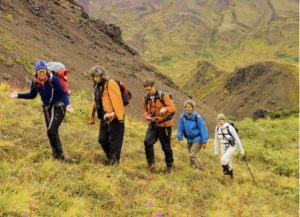Camp Denali
A spectacular wilderness lodge

Family-owned and operated by Simon Hamm and his wife Jenna, Camp Denali is a spectacular wilderness lodge in the heart of Denali National Park in Alaska. The 67-acre camp is situated near the treeline; it provides access to native tundra and boreal forest habitats for guests from all around the globe who come to be close to the land and experience Alaska’s unique wilderness. Founded in 1952, it is Alaska’s first business to engage in experiential learning about nature and cultural heritage—more recently referred to as ecotourism—and offers guests comfortable accommodation in 19 private guest cabins.
Camp Denali’s off-grid isolation demands alternative operating solutions
As a remote and truly isolated camp, it is powered using solar energy. Communications rely on redundancies from satellite networks, and before 2021, it was accessible via the 90-mile single-lane gravel Denali Park Road and by air.
Challenge
Access road closure
In August 2021, the Pretty Rocks Landslide occurred along Denali Park Road at Mile 43, causing the road to collapse and forcing its closure. Until then, visitors to Camp Denali and other locations within the park relied on this access route. The project to reopen the road, expected to cost $250 US million, is challenging. The site of the landslide is remote and steep, and because of the extreme weather conditions, the construction season is short. The planned repair is to build a bridge where the road collapsed, and it’s not expected to be completed before the summer of 2027 when the Polychrome Area Plan is implemented.
Fly-in fly-out option
Faced with the possibility of having to close due to the lack of visitors—along with several neighboring lodges and scenic tour operators in the area—Simon took the lead in researching fixed-wing and helicopter options to bring visitors to Camp Denali and the surrounding area.
The importance of good imagery before flying

He knew that having good imagery before flying is critical in Alaska, as distances are great and weather conditions are unpredictable. Before the road closure, the FAA had weather cameras operating in the region, greatly enhancing aviation safety; however, the unstable power infrastructure and a lack of staffing made camera operations unreliable after the road closure. Simon felt confident he could solve the problem by installing cameras on his property close to the aircraft runway. In his favor, he could provide reliable power to a remote monitoring system, and because he was on site, he could handle equipment repairs himself, e.g., replacing a wire if a squirrel chewed through it. So, as well as searching for a reliable aircraft partner, he also set about finding a rugged and reliable remote monitoring camera system.
Solution
The search for the perfect remote satellite camera system
Shortly after the Pretty Rocks Landslide and Denali Park Road’s collapse, Simon started to look for the perfect monitoring systems. Nupoint’s solution rose to the top of the list, and when he heard Denali National Park had also identified Nupoint as a reliable solution, he moved forward. Since then, he owns and operates three Nupoint remote monitoring cameras on his private property—affording east, south, and west views along popular flight routes. The pictures these systems capture provide the aircraft crew with invaluable information about the weather conditions at Camp Denali, which has become the hub and a gateway to visitors staying at Camp Denali and surrounding areas.
Aerimis operates on the Iridium satellite network—the gold standard
Most recently, Camp Denali installed the new Aermis satellite camera system. Aermis operates on Iridium’s satellite network. Simon confirms that Iridium is the gold-standard satellite network in his location and is very robust. The camera, located down in a valley, points to the runway and beyond, giving us a view of the open valley, ceilings, and potential weather to the west. This unit captures images every 15 to 30 minutes during the day. The quality of the pictures is excellent, and they are uploaded to a weather website for easy access by the aircraft pilots flying into Camp Denali.
Why Nupoint’s remote monitoring systems?
Looking back, Simon reflects that there were three deciding factors when selecting Nupoint: 1. Denny Capps, Denali National Park geologist’s recommendation; 2. His pre-purchase conversations with Tony Herunter, Nupoint’s sales lead, who provided a degree of customer service that is among the best of anyone he’s ever dealt with; and 3. Many of the other options he researched were considerably more costly.
Camp Denali continues to thrive despite the road closure
The Camp Denali Nupoint season operates from early May to mid-September when the lodge is winterized. Simon uses a Nupoint camera each spring to monitor the snow melt before the season begins. Another feature he enjoys is having the latest images from his Nupoint cameras at his fingertips via a link on his mobile device. It’s been three years since the Pretty Rocks Landslide catastrophe, and Camp Denali and its surrounding scenic lodges and tour operators continue to operate successfully, thanks to Simon’s leadership and innovative approach. And he generously shares images with all the locals, who benefit equally.
 There are many things I appreciate about working with the Nupoint team. First, Nupoint offers excellent customer service. Data costs can get out of hand, but Nupoint offers flexible plans that make it affordable for us. Nupoint’s equipment is well-engineered and manufactured, and it arrives in a box ready to go with minimal assembly—we’ve never had Nupoint equipment wear out—it’s just all quality stuff! And lastly, the portal where I can access all images and manage my systems is straightforward to use and makes my life easy, too.”
There are many things I appreciate about working with the Nupoint team. First, Nupoint offers excellent customer service. Data costs can get out of hand, but Nupoint offers flexible plans that make it affordable for us. Nupoint’s equipment is well-engineered and manufactured, and it arrives in a box ready to go with minimal assembly—we’ve never had Nupoint equipment wear out—it’s just all quality stuff! And lastly, the portal where I can access all images and manage my systems is straightforward to use and makes my life easy, too.”
What happens in 2027 when the road reopens?
Simon has given a lot of thought to what will happen when the road reopens. Visitors who take the scenic drive have many advantages; on the other hand, flying has advantages. Time will tell, but at the moment, Simon is leaning towards a drive-in, fly-out model to give his visitors the best Alaskan wilderness experience possible.
All images courtesy of Camp Denali.


